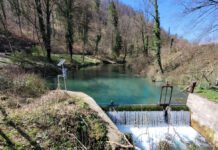Falling beach levels at Colwyn Bay, which have been eroded by both frequently occurring and more severe storms, have left the sea wall exposed and therefore at risk of damage from the sea.

Part of Phase Two of the Colwyn Bay Waterfront Project includes replacing the lost sand with a beach recharge, which will renew the natural sea defence, and at the same time, improve this local community asset and visitor attraction.
Conwy County Borough Council wants to assure the longevity of the new beach, which has to date involved the placing of approximately 500,000 m3 of dredged material, and has commissioned HR Wallingford to conduct physical modelling to estimate its future lifespan, taking into account the coastal storms that this area is exposed to.
In a 35m x 50m wave basin in its modelling facilities in Oxfordshire, HR Wallingford’s coastal engineers have created a detailed physical model of a 1.6 mile (2.6km) section of Colwyn Bay at a scale of 1:50, from Rhos Jetty in Rhos on Sea, eastwards towards Beach Road, Old Colwyn.
A bank of 56 individual wave generators, with wave probes placed in the basin to measure the waves generated, is being used to simulate typical weather and storm conditions.
Tom Rigden at HR Wallingford, said: ”We’ve been working closely with Conwy Borough Council, and with Alan Williams from Coastal Engineering UK, and drawn on their experience of the site, which has enabled us to ensure the physical model accurately replicates the natural processes that Colwyn Bay is exposed to.”
Engineers are using the complex physical model to calculate the rate of loss of the beachline, and give an estimate of the number of years it will take to erode, as well as advise on possible further protection measures if required.
Tests using the physical model will take several months, and are due to be completed at the end of March 2017.
Geraint Edwards, Head of Environmental Services at Conwy County Borough Council, said: “Having a physical model of Colwyn Bay provides us with a valuable tool in the design process of our coastal defence scheme.
It means that the design can be tested and optimised to suit the specific conditions.”
The project is a major investment into the redevelopment of the town’s seafront, aimed at safeguarding the town and its infrastructure from the threat of the sea and predicted climate change for years to come.
The project combines the renewal of coastal defences with regeneration improvements to the promenade, creating a modern and sustainable waterfront for the local community and visitors.






